Executive Summary
When preparing comprehensive financial plans, financial advisors must consider their clients’ entire financial situation, which consists of a variety of distinct components, ranging from investment account balances to diverse sources of cash flow to retirement goals and more. In isolation, each separate component might give a financial advisor only a certain limited perception about their client, but falls short in providing a full picture of who the client is and what they aim to achieve. Financial advisors can apply the principles from one school of thought, Gestalt psychology, which posits that humans perceive their environment in a holistic manner that is different from the sum of its individual parts. By doing so, they can create holistic plans that are relatable to clients on a much more meaningful level, as they consider not just the quantitative aspects of the client’s financial life (e.g., their assets, liabilities, income, and expenses), but also the important qualitative factors such as goals, lifestyle preferences, and personalities.
In order to help advisors and clients see the bigger picture, the company Asset-Map created a tool that works well from a Gestalt perspective by providing a graphic summary of a client’s entire financial situation. These summaries are presented as a one-page, mind-map-style report, which helps advisors to quickly draw out patterns and formulate holistic perceptions that are relevant to the client’s broader environmental contexts, including where they are in their career, their family situation, and stage in life. Asset Maps can also be very useful for advisors to have more targeted and fruitful conversations with clients, as the advisor can easily and quickly target specific areas that need to be reviewed. For example, because Asset Maps separate income and assets by spouse, advisors can easily assess the relative life insurance needs of each spouse, and even have a better idea of each spouse’s individual Social Security considerations. This valuable context can be highly relevant to making sense of a client’s actual situation as a whole, and can also be a useful way for some advisors, who may initially feel hesitant to present this division (perhaps fearing that the spouse with lower income may feel less valued when incomes are displayed this way), to broach these discussions in the first place. Because the details here – the income and assets belonging to each spouse – are what provide a level of additional clarity that would have otherwise gotten washed away had those details not been broken down by spouse.
For clients, an Asset Map provides a useful summary of their household, showing them how all the individual pieces of their financial lives interact and create their broader financial situation. Having all the information in an easy-to-understand format and in one place also can provide clients with the reassurance that their advisor has captured and considered all of their financial details (and help them to easily see if they need to let their advisor know about any pieces of important data that may be missing!). Which means that as long as the advisor is proactive in keeping the client’s information updated, clients can be reassured that their financial situation is being managed from a more comprehensive perspective.
Ultimately, the key point is that by analyzing a client’s financial situation with Gestalt psychology principles in mind, viewing the whole picture as a complete unit rather than analyzing the individual parts separately, financial advisors can visually take stock of the client’s broader financial situation. This can result in not only better-informed and more confident clients, but also improved client data tracking and financial planning recommendations!
Perception is a tricky issue. As we navigate the world around us, we are constantly trying to make sense of our surroundings by applying various abstract mental models that help us successfully do so. Psychologists have developed various schools of thought that address how perception works and how we tend to make sense of our complex worlds.
Gestalt psychology (“Gestalt” is a German word referring to ‘pattern’ or ‘configuration’) is a school of thought that could be summarized with Kurt Koffka’s famous statement:
The whole is other than the sum of its parts.
In other words, Gestalt psychology posits that we don’t just perceive our environment as a collection of many individual items in an additive manner; but rather, our perceptions are formed in a more holistic manner.
For instance, when you ‘see’ a desk, you don’t just see the desk by itself. You also capture that it is nested within a tidy office, nested within a Class A office building, nested within an upscale office park – which is apparent via the view from the expansive corner office suite windows. Manipulate any of these variables, and the ultimate perception of the desk may change.
You may likely be more familiar with the translation of Koffka’s statement, “the whole is greater than the sum of its parts”. Koffka actually pushed back against this translation of his statement, as he felt that the key insight is not that the whole is necessarily greater in some sense, but that we perceive the whole of something as entirely different from its constituent parts.

Nerd Note:
The phrase “the whole is greater than the sum of the parts” is also commonly misattributed to Aristotle in his Metaphysics, in which Aristotle actually says, “…the totality is not, as it were, a mere heap, but the whole is something besides the parts” and “…that the whole is not the same as the sum of its parts.” Although more than 2,000 years before Koffka, Aristotle’s statement is actually remarkably similar.
The key point here is that we do tend to formulate holistic perceptions of the world around us that are uniquely different from how we would perceive the components, by themselves, that make up the world around us. And, in doing so, we can often gain valuable insight.
Suppose you see (a) a coffee pot, (b) a cup of coffee, and (c) an open container of creamer in two different contexts: (1) an office break room and (2) a dumpster. Gestalt psychologists would contend that we would perceive these constituent items within their different environmental contexts very differently. Notably, they’d suggest we aren’t building up a representation of the world in each case item by item. Rather, we’re assessing the totality of what we see and then making inferences about constituent elements (if any) within that context.
So, for instance, if we’re going to guess whether the cup of coffee in both contexts is hot or cold, we’re more likely to suspect the coffee in the break room is hot and that the coffee in the dumpster is cold. We don’t actively think about this, but as we perceive the whole, it’s the type of probabilistic assessment that is just going to come within the holistic context. Notably, this applies not only to vision but also to our perception of more abstract concepts as well.
We often struggle to articulate and even appreciate our perceptions operating in this manner, but a common example is when we get the feeling that something is off. Many have probably had the feeling of walking into a room and feeling like something is missing. We may not notice it right away, but our mind’s perception of the whole has detected it, and as we then look closer, we may discover exactly what is missing. Or, similarly, we may be in a situation where someone catches our attention. We don’t know exactly why or what they are doing, but something about their behavior doesn’t fit our mind’s mental model of what’s ‘normal’ in a particular environmental context, and then we seek to investigate further and uncover the discrepancy.
If the Gestalt psychologists are correct, we first see the whole and make inferences about constituent elements rather than seeing the constituent elements and building up an inference about the whole.
And this insight is relevant to all sorts of perceptions, including those that we use and formulate as financial advisors when working with clients.
How Asset-Map Offers A Holistic Perspective Of Client Situations
Asset-Map is a company that was founded about 13 years ago by H. Adam Holt, originally designed to provide an internal financial planning tool to better serve Holt’s own clients. Recently, Asset-Map received the highest advisor rating of financial planning software (though it’s not quite the same as ‘traditional’ financial planning software, as explained further momentarily) and the highest increase in market share within the 2021 T3/Inside Information Advisor Software Survey. Asset-Map was also the leader in both current and future adoption categories among advisors in the “Mind Mapping” category of our recent 2021 Kitces Research Tech Survey.
One of Asset-Map’s most unique features is the way that it provides a summary of a client’s entire financial situation in a one-page mind-map-style report. For instance, here is a sample for a young family:
The value of this view is worth contemplating from at least two different perspectives: the advisor and the client.
Advisor Value Of An Asset Map
So why all of the talk about Gestalt psychology? From a Gestalt perspective, Asset-Map provides a very unique approach to viewing one’s finances, and there’s a lot going on that may be easy to overlook. Why? Because it makes it incredibly easy to see a client’s whole picture, and, mistranslations be damned, in this case, the whole is greater than the sum of its parts.
Before diving deeper, it is important to acknowledge that when we are formulating a perception of a client’s situation, it is helpful to acknowledge that clients are individuals nested within careers, nested within households (e.g., single, couple, or otherwise), nested within stages within a lifecycle (e.g., early career adults, retirees, etc.), and nested within lifestyles (e.g., lavish, frugal).
I’ve certainly missed some important levels of abstraction here, but you can think of each of these abstractions as concentric circles extending out from the individual, each encapsulating some additional insight that is useful for generating a holistic perception.
Moreover, what Asset-Map does well – that is not generally done by other (traditional) financial planning software – is to help advisors draw out patterns and formulate holistic perceptions that are relevant to these broader environmental contexts really quickly.
For example, in the one-page sample Asset Map shown above, we can see that the client is a 36-year-old couple with a household income of $183,000 and a net worth of approximately $244,000, which gives us some insight into their spending and saving habits. We can also see factors that offer a broader perspective of their lifecycles, such as the fact that they have a 7-year-old child and their employment positions.
The totality of the client’s financial situation offered by Asset-Map is unique from a balance sheet and P&L statement as it's not just about the asset values; it's the mix of particular assets, liabilities, insurance, demographics, income, and other factors also included right on the Asset Map that collectively (and efficiently!) provides a far richer picture than just looking through financial statements.
One interesting aspect of the Asset-Map software is how it separates out income and assets by spouse. This could be a contentious issue among advisors. On the one hand, some may feel it is best to think of a household holistically, and from that perspective, there’s reasonable concern that this sort of framing could leave a stay-at-home spouse listed with “$0 income” feeling underappreciated (e.g., where all of the income and assets are tied to one spouse, but the reality is that the work of the other spouse is contributing to those income and assets).
However, from the perspective of looking at an Asset Map and quickly making sense of a client’s actual situation as a whole, such contextual factors are highly relevant. For example, knowing that one spouse stays at home is useful. Alternatively, knowing that both earn the same (if that were the case instead) is useful. Knowing that both have successful careers outside of the home, but one spouse still earns 10 times more than the other spouse is also helpful. Etc., etc.
While one alternative could be reporting all income and assets at the household level, from a Gestalt perspective, this makes it much harder to quickly formulate an understanding of the client’s situation.
Imagine you know the following:
- Husband and wife both have MD degrees
- Both are age 40
- Combined family income is $500,000
- No debt
- $1 million in investible assets
With this information alone, you’ve probably started to formulate some perception of this household, but there’s a lot that we simply don’t know. Nonetheless, in an Asset-Map-esque structure, we might formulate a household-level map that looks something like the following:
Now contrast the graphic above with the following graphics below that would also all still be consistent with this scenario.
With a little effort of including further detail in the visual map, you can likely start to develop a more vivid picture of some important qualitative details about each of the different households above.
For instance, in Scenario A, we have a balanced dual-income household scenario. This alone tells us quite a bit about potential roles within the household and the balance of contributing to the household financially.
In Scenario B, we have an unbalanced dual-income household. Now we may be cognizant of some different relationship dynamics that may be present. Additionally, we can see that this is a household where the wife earns significantly more than the husband – an increasingly common occurrence – which also sheds some unique perspectives on some potential dynamics of this household.
In Scenario C, we have a scenario that appears to be consistent with a stay-at-home spouse along historically traditional gender roles. The lack of any assets in the wife’s name may raise questions about whether she ever practiced as a medical doctor. Of course, it’s possible she did, and they focused on paying down student debt, but seeing the information broken out this way at least raises the question.
And in Scenario D, it may at first glance look like a stay-at-home-spouse scenario, but we get some pause from the fact that the bulk of the assets are in the wife’s name. Is this a temporary break in employment? An inheritance? Something else? Of course, we can’t know the answer from the information provided, but the areas our mental model starts to break down are precisely the areas that we likely need to investigate further.
And that’s the key point. The details here – the income and assets belonging to each spouse – provide a level of additional clarity and understanding to our mental models that would have otherwise gotten washed away had we not broken those details apart by spouse. And then queues up the opportunity to have more targeted conversations that are more fruitful with clients, as it gets the advisor more quickly to the areas that they may want to probe for still more information in the discovery process.
Even though this approach may involve a genuine risk of making one spouse feel underappreciated, there’s also genuine value (at least from the advisor’s perspective) in seeing how the component parts, at a more granular level, play a role in the overall picture. Because, again, the sum of the parts is greater than the whole.
And, of course, we can further enrich our mental model with a wide array of details. Refer again to our Asset Map sample:
All of the details that can be extracted help paint a more nuanced picture of this household in a quick manner. Furthermore, while some may feel that there’s ‘too much’ on an Asset Map, a key benefit of this type of map is actually the ability to start at the center of the map and then to explore outward, seeing information captured at various levels of abstraction as the eye takes in all the information on the (single) page.
For instance, we can start with just the two individuals, Neil and Lauren, and note that they were both 35 years old at the time of running this report.
Then we can quickly see that Neil and Lauren have $103,000 and $80,000 in income, respectively. If we wish to stop at this level of abstraction, we can; otherwise, we can choose to dive deeper and figure out the component parts of this income. Likewise, we can do the same with individually owned assets/liabilities, joint assets/liabilities, insurance, and even other household characteristics such as the presence of dependent children and professionals consulted (CPA, attorney, etc.), as reflected near the top right of the page.
We can follow the paths within the map to nodes of higher or lower levels of abstraction based on our need, but the fullest picture of a household is going to come once we consider the totality and the insights those provide.
For instance, consider the fact that Neil has a $25,000 E*Trade “Play Account”. Or the fact that their Roth IRAs are held at different custodians. All of these contextual details help paint a more vivid picture and may even influence how we think about their 401(k) plans or other accounts.
At the same time, if we only want high-level information, then that is readily available as well. (While not shown here, Asset-Map does offer the functionality to report household Key Performance Indicators such as net worth, total assets, etc., that can also be displayed visually on the same map.)
Asset-Map also makes use of colors and other visual cues to provide greater insight into a client’s situation. While such details will likely be lost on clients (other than using the legend provided), advisors who use the software regularly will start to visually associate colors with certain types of accounts (e.g., dark blue with insurance). Even without reading all of the details within a given map, an experienced user will start to draw quick insights from this color coding (e.g., someone has many sources of income, many retirement accounts, a lack of insurance, etc.).
The groupings throughout the page also work well. Dividing the page into different zones (top for insurance; left for Spouse 1 income and assets/liabilities; right for Spouse 2 income and assets/liabilities; and bottom for joint assets/liabilities) makes for easy and efficient visual evaluation.
And while the point here is not to provide a thorough review of Asset-Map (though the tool does also include a slick client questionnaire, as well as a more traditional Needs Analysis for various goals, insurance, etc.), the Asset-Map report paints a picture of a household in a way that no other software currently on the market does.
In a way, Asset Maps actually serve as a visual CRM. Personally, if I get an unexpected call from a client, pulling up their Asset Map is the safest way for me to make sure I’m not going to misstate any details. Birthdates, children's names, professionals used, account types/balances, employer, income levels, insurance carriers, etc., are all very quickly available within an Asset Map that I know how to navigate and where to find the information I need. Taking advantage of the notes functionality within each account also allows for easy access to information (e.g., a Google Drive link to an insurance policy could be added within the client’s Asset-Map record as a note for quick retrieval).
Of course, this may not be apparently valuable to the end-client (though having a more organized and better-informed advisor can save the client’s time and offer confidence that their advisor understands their situation), but this is a key potential value of Asset-Map for advisors.
Additionally, Asset-Map includes some light financial planning capabilities that can be carried out quickly once an Asset Map is built. The planning functionality is mostly goals/needs-based, time-value-of-money-calculator kind of planning, but it works well for giving a quick initial assessment of a client’s situation. For instance, with just a few clicks, “Target Maps” can show current funding levels for life insurance, retirement, education, and other planning goals.
In my own practice, Asset-Map has become my primary tool with prospective clients and serves as a sort-of-visual CRM. I will build out an Asset Map for pretty much every prospect during a discovery call, if for no other reason than to be able to jog my own memory in the event that the prospect goes stale but then contacts me again in 6 months (as it’s much faster than poring through notes in my CRM). It also serves as a nice template to work from if I’m inputting client information into different software.
Additionally, the light planning functionality helps give some quick assessments of a prospect’s situation. Asset Maps generally aren’t my final destination for more in-depth financial planning analysis – I’ll switch over to other tools to carry out retirement projections, tax projections, etc. – but it does help identify areas where digging deeper would be helpful. Furthermore, the light planning that it can do could be good enough for those implementing solutions such as term life insurance for clients, as Asset-Map is already doing similar calculations to most planning software to address these issues.
Client Value Of An Asset Map
In addition to the value that Asset Maps provides to advisors in the advisor-client relationship, it is also worth thinking about the value that they add for clients more directly as well.
While this is just my anecdotal experience, my Asset-Map reports are the only output from a financial planning software program that I’ve ever had clients proactively ask for a copy of. Following Matthew Jarvis’ advice to figure out what is valuable to a client based on what they actually want to take with them, Asset-Map has, in my case, passed this test with flying colors.
Some may object that an Asset Map itself is not necessarily the most polished or visually appealing report you’ll ever see (notably, it did recently receive an updated interface shown in the images above), but even so, it’s not the beauty or the polish of the report that is valuable to clients. It’s the usefulness and relevance; it’s the Gestalt perspective it gives them regarding their own household when they can see all their own finances in one place.
And while it is worth considering whether there is “too much” on any given report – as too much information could result in cognitive strain – I actually suspect that what may seem like messiness in an Asset Map is actually part of what is driving the perceived value among clients.
After all, any mind map that contains the nodes farthest out to the end of the branches is generally going to look a bit messy. But the value of such a presentation is that it does allow a client to see that there’s a lot going on, while still being brought together as part of a single plan that connects back to the center.
In turn, clients can follow the paths out to the end nodes if they want, with some higher-level abstractions provided along the way that help avoid needing to do mental math (e.g., the summation of Neil’s $103,000 of personal income in the example above), but, to the client, it’s not so much the need to see all of the details as it is the reassurance that all of the details are there and it’s visibly clear they’re being captured and considered.
In other words, the client visually starts to better understand their full picture while also building their confidence that details aren’t being looked over. In addition, clients can easily ‘audit’ an Asset Map by seeing whether a certain category includes everything. For example, did an advisor miss one of their income sources? Are the details accurate? Etc. In some cases, clients may volunteer information they otherwise haven’t shared (or weren't ready yet to share) with their advisor, simply because they don’t want their Asset Map to look incomplete!
So long as the advisor is proactive in using Asset-Map to update assumptions and information, clients will likely have considerable peace of mind in knowing that their financial situation is being looked at from a more comprehensive perspective.
Furthermore, just as is the case for advisors, clients may start to perceive components of their financial situation differently when viewing it through a lens of the whole rather than individual parts. For instance, a client overly focused on the performance of a single account may broaden their own view once they gain a higher-level perspective – by seeing it all right on their Asset Map – that this particular account makes up just 5% of their net worth.
Ultimately, whether it is the value provided to advisors or the value provided to clients, Asset Maps are visually unique tools that take good advantage of Gestalt psychological principles to convey useful information about one’s financial situation.
Whether Asset-Map serves as a ‘visual CRM’ to quickly understand a client’s situation or a deliverable that builds confidence in the client’s eyes that planning considerations are not falling through the cracks, a visualization such as an Asset Map may provide a whole that is greater than the sum of its parts.


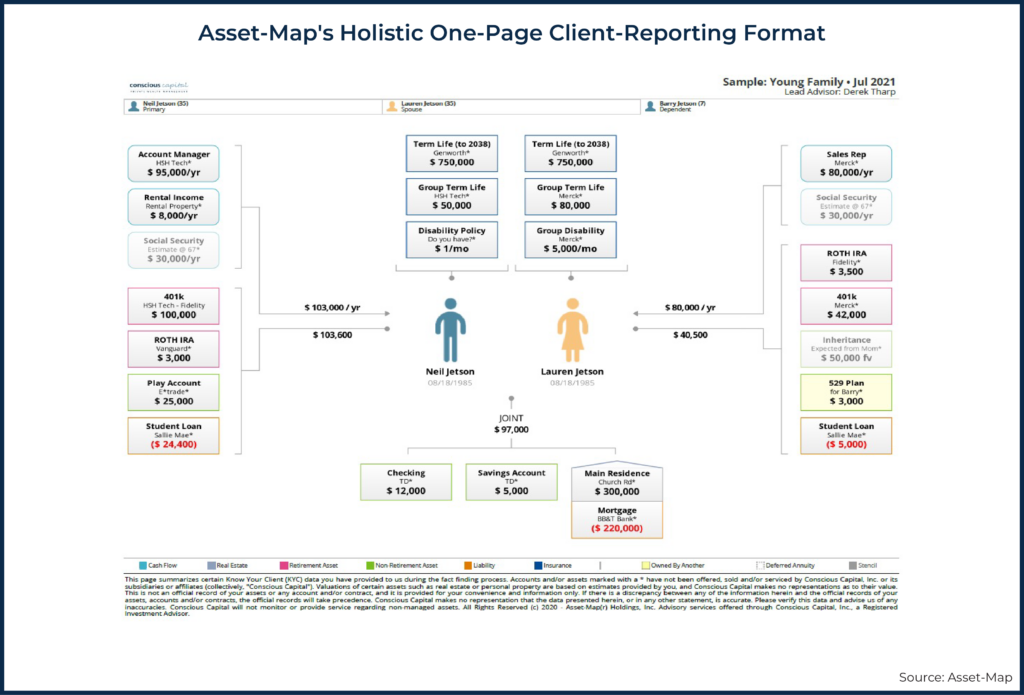
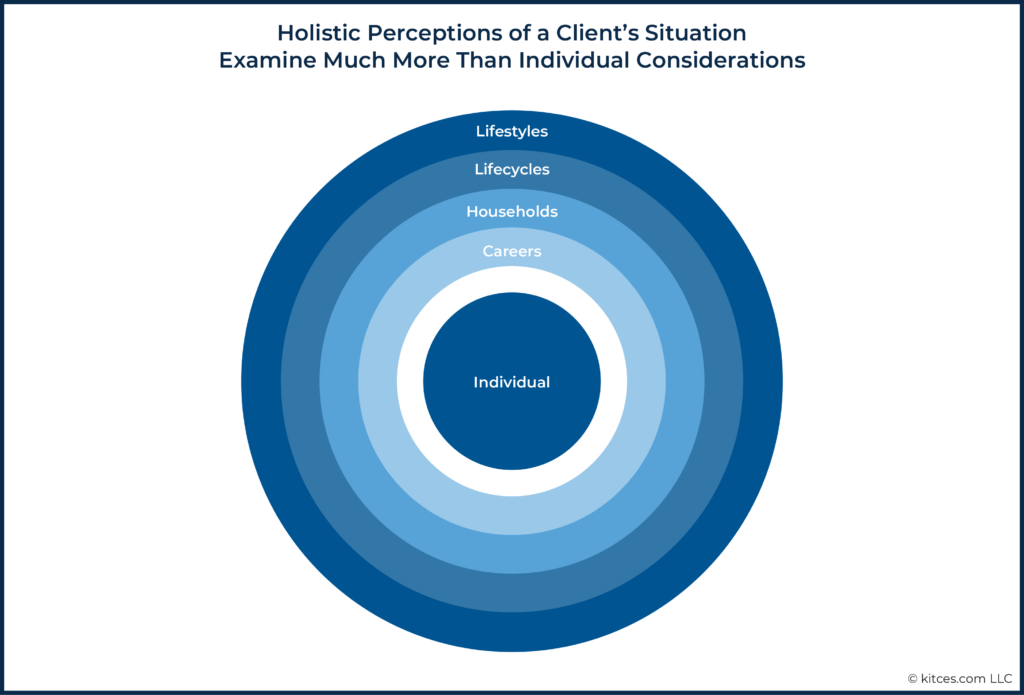
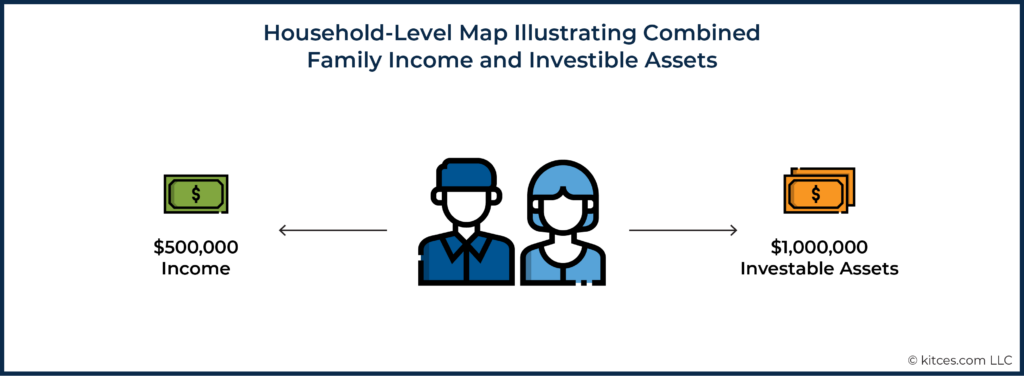
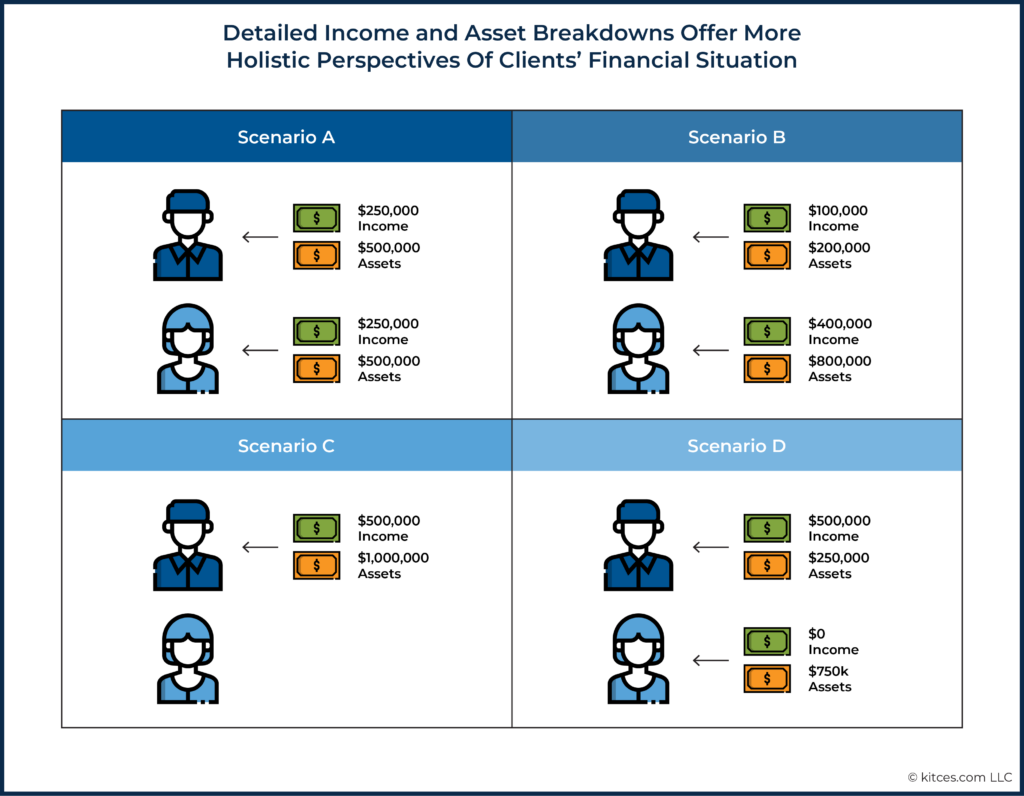
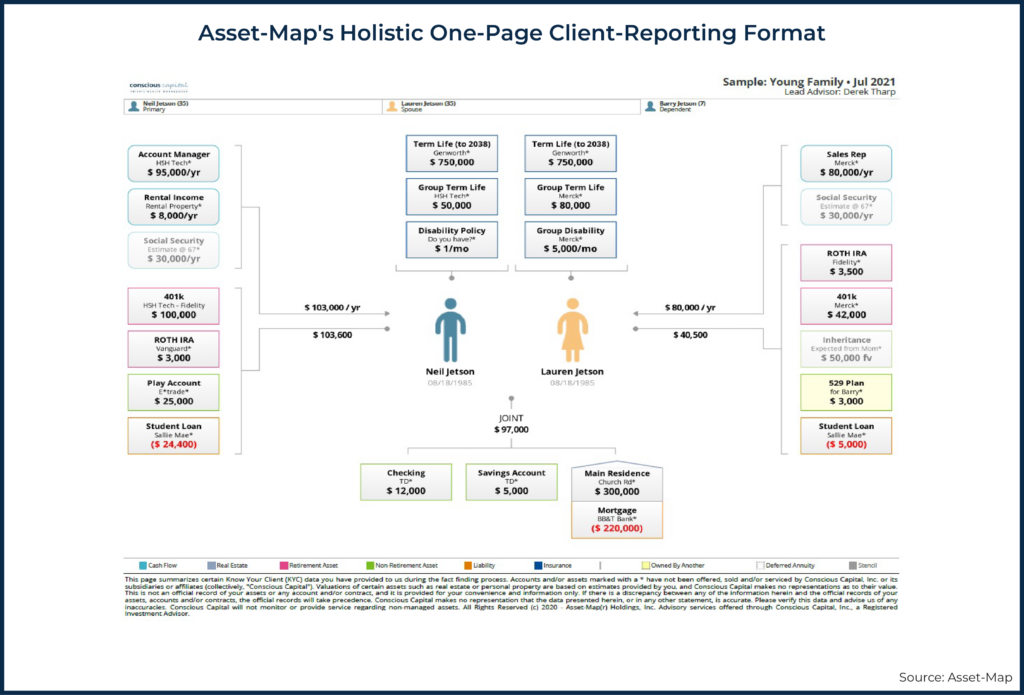



Derek, thanks for a great article. The software looks very cool. One question: can you link the displayed client account values in Asset Map to the underlying balances at the custodian? In other words, can I get a data feed to update those account values automatically in Asset Map, or do I have to manually update them? My apologies if the answer is mentioned somewhere in the article. Thanks, Michael
Thanks, Michael! I think that will depend on whether they have an integration built out for your custodian (or other software you use; see here https://www.asset-map.com/integrations ). Looks like they have a direct integration to TD Ameritrade through Veo. Other custodian might be available through an additional step if you use Orion, Black Diamond, or another integrated platform. They also have an integration with PreciseFP which opens up a lot of doors. For instance, while I haven’t actually set it up, I should be able to link to my custodian as follows: Folio Institutional –> Blueleaf –> PreciseFP –> Asset-Map.
You can link to some custodians but not all.
Right now Asset-Map can accept values and members from PreciceFP which integrates with multiple parties CRM/Planning. Our most popular 5 integrations are with Riskalyze, Redtail, Orion, WealthBox, TDVeo in that order. MGP can push to Asset-Map. Blackdiamond can publish the Asset-Map to the client portal. Salesforce Enterprise has been enabled for larger firms. File storage with Box.com, Dropbox and Google Drive is pending release. Plenty in the hopper,in the CRM, investment and Planning space.
Nice write-up. I have found Asset-Map to be a fantastic addition to an advisors tech stack.
What about when Neil and Lauren (as my wife and I do) have 25 separate accounts — and that’s after paring down! Can you fit all that on one page?
Just put together an example with 25 accounts in one spouse’s name to see what would happen. Asset-Map can still get all of those on one page. Naturally, it gets pretty condensed. I think it would probably make more sense for Asset-Map to stack (i.e., create multiple columns) accounts rather than putting them all in one column for cases like this, but I’m sure they’ll continue to refine their offering over time. And, for what it’s worth, I’ve put together a lot of Asset Maps and never encountered a situation with that many accounts. I’m sure there are advisors with some complex, ultra high net worth clients that may need that for every client, but for anyone working in the mass affluent / HNW categories, this probably isn’t a common occurrence. https://uploads.disquscdn.com/images/04d269f942c4032a6a4a1beb62a9a8d14e2b8d795860871eded1eecd2ebdfe0d.png
Derek and J’adoube – what tends to happen is you simply view the single member on their own as opposed to a two-person view. That way we have more space to work with. Alternatively, if someone has multiple financial instruments, they are typically owned within other entities (Trusts, businesses, etc.) and so in this case you roll up the ownership/control to those other entities true to balance sheet. You can create multiple views of a household, 1, 2, 3, +++ party views to have different discussions. i.e. just the kids, or single mom, or FLP and partner, or all trusts.
Thank you for such a thorough write up Derek. You capture a great amount of the field-thoughtfulness intended in the Asset-Map Platform.
We used to joke that “if we only had a platform that was 20% CRM, 30% Financial Planning, 10% Suitability, 40% yellow pad with an HP calculator attached that presented on one page/screen” -we would be golden. So that is what Asset-Map attempts to be… just what we actually use in the real world. Nothing else.
Today it’s all about client engagement and elevating the advice delivery experience. After all, it’s where all of us in the professional business earn our relationship credibility.